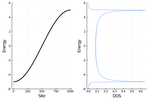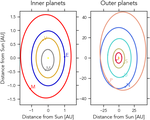Biography
I am a postdoc at the MPI CPFS (Intermetallic Chemistry Group). I have a PhD in theoretical and computational chemistry. Currently, I am working on extending Interacting Quantum Atoms to solid state systems. My interests include topological quantum chemistry, chemical bonding, and scientific computing.
Besides theoretical chemistry, I am enthusiastic about the rise of quantum computing and machine learning. Biking and snowboarding are two of my favorite hobbies.
Sometimes I write about science using Julia in this site. Stay tuned!
Download my resumé.
Interests
- Quantum Chemistry
- Scientific Computing
- Machine Learning
- Quantum Computing
Education
-
PhD in Physical Chemistry, 2017
University of Oviedo
-
MSc in Physical Chemistry, 2014
University of Oviedo
-
BSc in Chemistry, 2012
University of Oviedo
Skills
Julia
90%
Python
90%
C++
70%
LaTeX
90%
Fortran
90%
Git
60%
Accomplishments
Scientific Trends at the Interfaces Mathematics – Chemistry – High Performance Computing - ICS Summer School
Solid State Chemistry course
Excited states chemistry course
Recent Posts
Scientific Memes
Projects
Tight binding tutorial
Recent & Upcoming Talks
Featured Publications

Interacting Quantum Atoms Method for Crystalline Solids
An implementation of the Interacting Quantum Atoms method for crystals is presented.
Real‐Space In Situ Bond Energies: Toward A Consistent Energetic Definition of Bond Strength
A rigorous definition of intrinsic bond strength based on the partitioning of a molecule into real‐space fragments is presented. Using the domains provided by the quantum theory of atoms‐in‐molecules (QTAIM) together with the interacting quantum atoms (IQA) energetic decomposition, we show how an in situ bond strength, matching all the requirements of an intrinsic bond energy, can be defined between each pair of fragments. Total atomization or fragmentation energies are shown to be equal to the sum of these in situ bond energies (ISBEs) if the energies of the fragments are measured with respect to their in‐the‐molecule state. These energies usually lie above the ground state of the isolated fragments by quantities identified with the standard fragment relaxation or deformation energies, which are also provided by the protocol. Deformation energies bridge dissociation energies with ISBEs, and can be dissected by using well‐known tools of real‐space theories of chemical bonding. Similarly, ISBEs can be partitioned into ionic and covalent contributions, and this feature adds to the chemical appeal of the procedure. All the energetic quantities examined are observable and amenable, in principle, to experimental determination. Several systems, exemplifying the role of each energetic term presented herein, are used to show the power of the approach.
Recent Publications
A multipolar approach to the interatomic covalent interaction energy
Interatomic exchange‐correlation energies correspond to the covalent energetic contributions to an interatomic interaction in real space theories of the chemical bond, but their widespread use is severely limited due to their computationally intensive character. In the same way as the multipolar (mp) expansion is customary used in biomolecular modeling to approximate the classical Coulomb interaction between two charge densities \rho_A(r) and \rho_B(r), we examine in this work the mp approach to approximate the interatomic exchange‐correlation (xc) energies of the Interacting Quantum Atoms method. We show that the full xc mp series is quickly divergent for directly bonded atoms (1–2 pairs) albeit it works reasonably well most times for 1– n (n > 2) interactions. As with conventional perturbation theory, we show numerically that the xc series is asymptotically convergent and that, a truncated xc mp approximation retaining terms up to l_1+l2=2 usually gives relatively accurate results, sometimes even for directly bonded atoms. Our findings are supported by extensive numerical analyses on a variety of systems that range from several standard hydrogen bonded dimers to typically covalent or aromatic molecules. The exact algebraic relationship between the monopole‐monopole xc mp term and the inter‐atomic bond order, as measured by the delocalization index of the quantum theory of atoms in molecules, is also established.
An unexpected bridge between chemical bonding indicators and electrical conductivity through the localization tensor
While the modern theory of the insulating state shows that the conducting or insulating properties of a system can be extracted solely from the ground state properties via the so-called localization tensor (LT), no chemical reading of this important quantity has ever been offered. Here, a remarkable link between the LT and the bond orders as described by the delocalization indices (DIs) of chemical bonding theory is reported. This is achieved through a real space partition of the LT into intra- and interatomic contributions. We show that the convergence or divergence of the LT in the thermodynamic limit, which signals the insulating or conducting nature of an extended system, respectively, can be nailed down to DIs. This allows for the exploitation of traditional chemical intuition to identify essential and spectator atomic groups in determining electrical conductivity. The thermodynamic limit of the LT is controlled by the spatial decay rate of the interatomic DIs, exponential in insulators and power-law in conductors. Computational data of a few selected toy systems corroborate our results.
Contact
- danielmail7@gmail.com
- 40 Noethnitzer Str, Dresden, Sachsen 01197
- Enter building and take the stairs to B.1.4.23 on Floor 4


